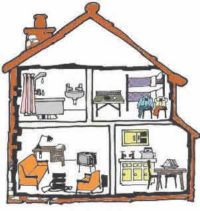Recently a customer asked us if we had any information on “steps to mouse proof your house” (response below also includes steps to rat or rodent proof a home as well). This is what we sent them. Last week another customer called us so we thought we would put the response in our blog.
Rodents, like mice and rats, are a problem year around, but this year, in particular, most of the country experienced one of the worse winters in decades. Unfortunately, with that you get mice and rats looking for a place to nest and searching for food and water. Your beautiful home looks like the best choice…..warm, food on the counters (or crumbs on the floor), plenty of water in and around the sink area or from leaky pipes, and the walls, attic, garage, basement, and kitchen offer great places for them to hide and nest.
Steps To Mouse Proof Your House
First a little bad news.
It is nearly impossible to TOTALLY rat or mouse proof your house even if it’s new construction. There will always be ways for the rodents to find their way in. Here are some of the most obvious ways for rodents to get into your home or business.
- We all leave the garage door up from time to time
- Windows left open with broken screens
- Entry door or backyard door left open
- Broken vents in the eves or foundation
- Cracks around pipes or stacks that either enter the house or exit the home like water pipes, sewer lines, kitchen stove or microwave vents, laundry room exhaust vents, electrical cable, roof exhaust vent pipes, etc.
- Cracks or gaps in the flashing around your chimney
Now the GOOD news.
You can drastically improve your odds of staying mouse or rat free. Here are some basic steps that you can try. If you already have a mice, rat, or rodent problem, then using a product like our DX610 Pest-A-Repel electronic plugin is your fastest way to get rid of the infestation that you have now.
If the mice are in your RV, camper, or motor home, checkout our blog on “What is the best way to keep mice and rats out of an RV?“
Some steps to mouse proof your house below are more specific to getting rid of mice than rats, but overall, they apply to rodents in general.
Steps To Mouse Proof Your House – Rats and Mice
- Clean your house from top to bottom.
- The kitchen is the primary target for rodents as they can chew on various things and get into the pantry and contaminate food.
- Secure all food items in your kitchen in rodent proof containers
- Remove all clutter from counters
- Do not allow food to be lying out in the kitchen
- Fix leaky pipes immediately
- Keep the counters and kitchen clean
- Pruning shrubs and trees so that the branches do not touch fences or hang down to the ground
- Rodent-proof your garbage containers
- Eliminating travel ways like ivy, tree branches and fences to reduce roof rat travel
- Cut back or eliminate ground cover plants
- Clear vines growing on home or business
- Try to eliminate potential water sources that can attract rats and mice or get them fixed. Same applies to inside your home.
- Get rid of attractants like pet foods (never leave uneaten pet food outside overnight), bird feeders, and outside water. Since rats and mice usually require water, especially during hot, dry weather, any source of water can be a strong attractant.
- If you compost, do not through meat, bones, fish, or other food scraps into the compost pile
- Rats can get into your home along pipes or utility wires or through garage doors that do not fit tightly
- Repair any gaps or holes. Prior rat damage in your home must be repaired and protected from future attack. Use a strong material to fix gaps. “Steel wool can be used as a temporary repair“.
- Have a shed? Place it on concrete slabs
- Cover attic and foundation vents with 1/4-inch wire mesh or heavy wire screen and check periodically for rust and other damage
Hope this helps you in staying rat, mice, and rodent free. If you are not sure what type of rodent problem you have, we have a lot of additional information on our website that you may find helpful.
1) How to recognize whether you have a MOUSE in the house
2) How to recognize whether you have a ROOF RAT in the house
3) How to recognize whether you have a NORWAY RAT in the house
